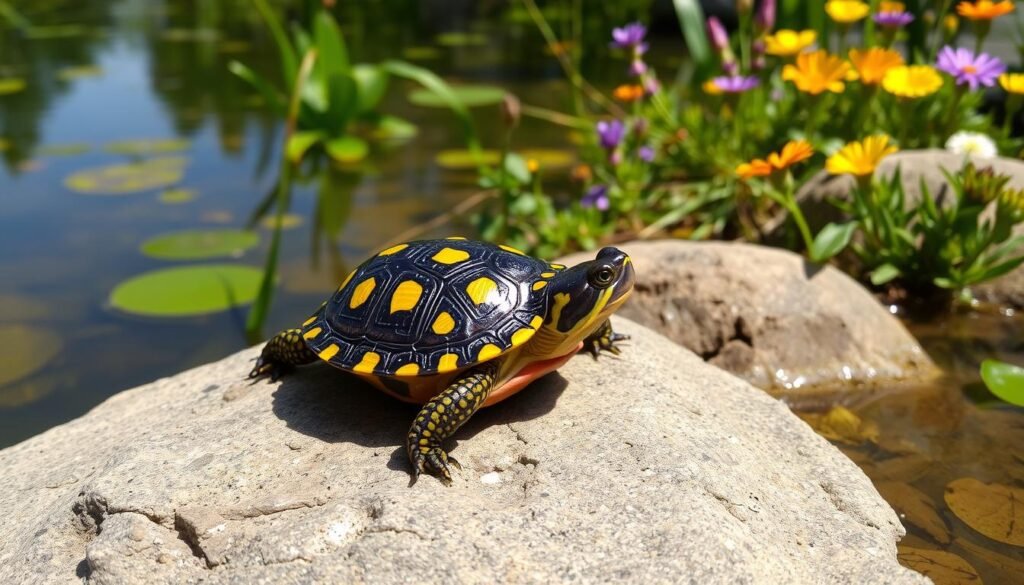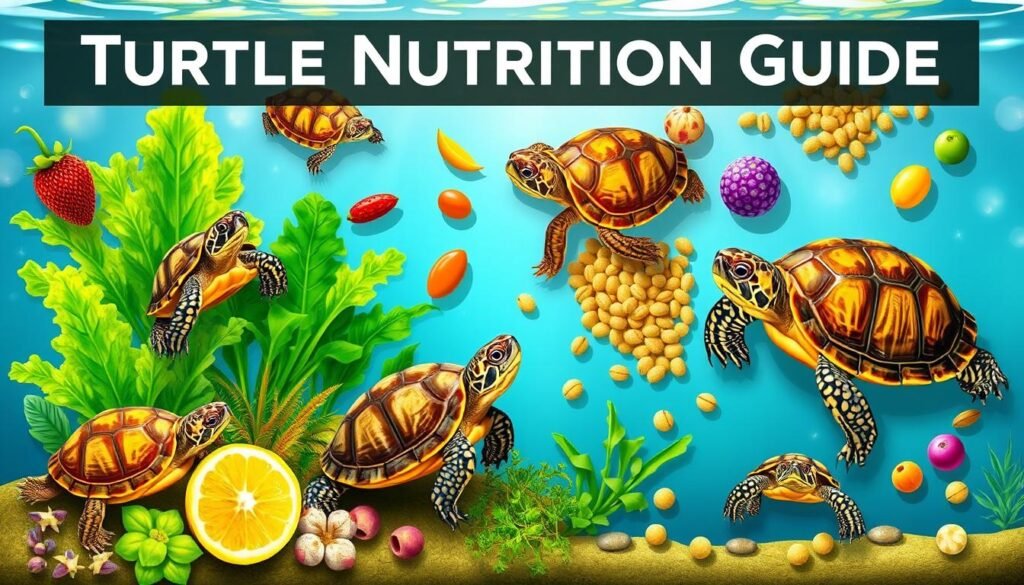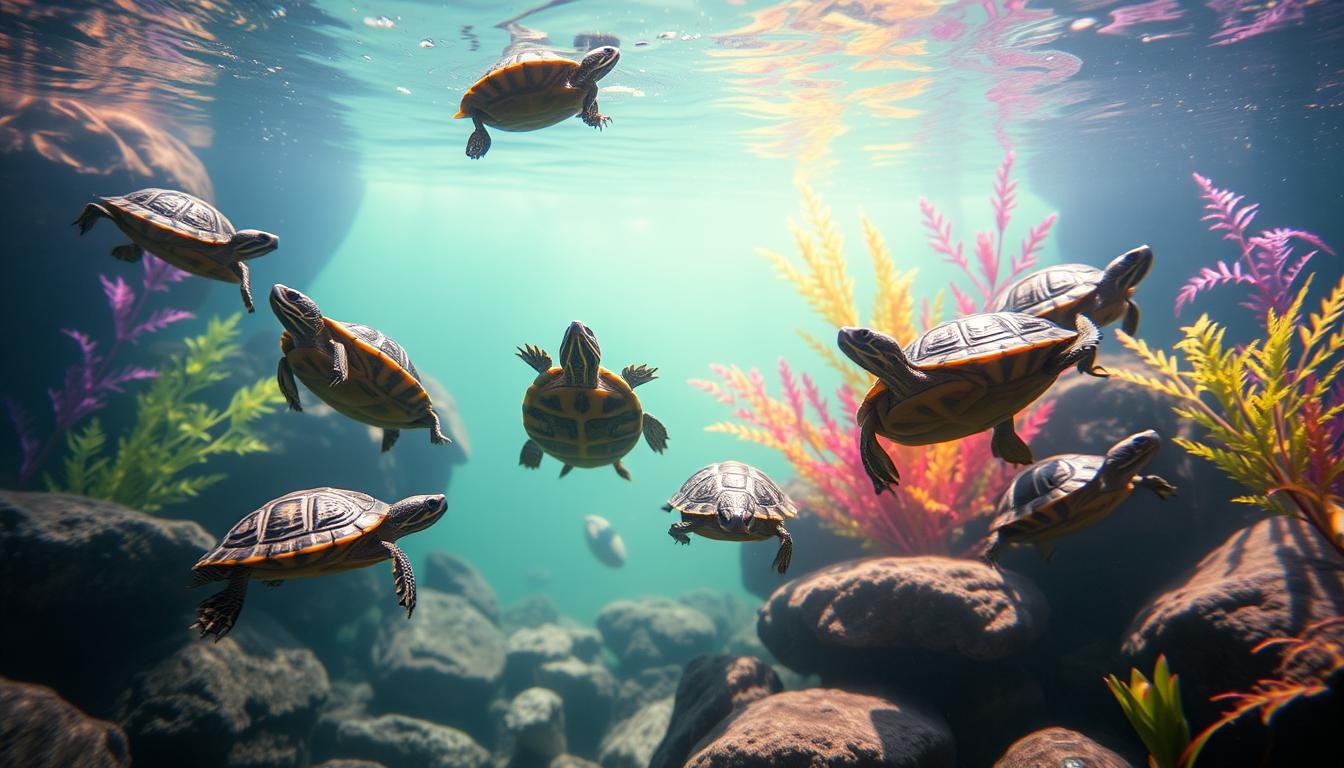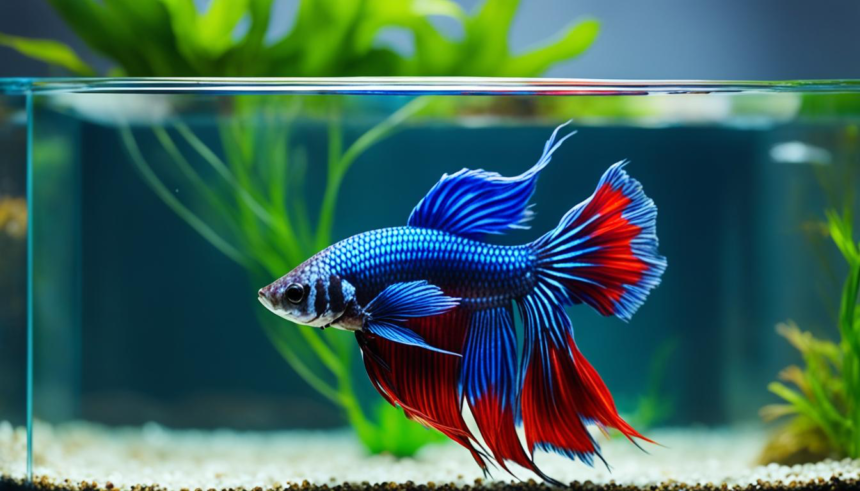Finding the right small pet turtle can change your reptile experience. There are both aquatic and land-dwelling turtles that are perfect for those who want a compact pet. These tiny reptiles are between 3 to 12 inches, great for people with little space.
Small turtles are a great choice for those new to reptiles. They need less care and are easy to handle. There’s a wide range of small turtles, so everyone can find the right one for their home.
There’s a lot of variety in small turtle species. You might be interested in the Musk turtle or the Spotted turtle. Each has its own special traits and needs. Knowing these helps you create a great home for your turtle.
When choosing a small turtle, think about their lifespan, tank size, and care needs. Some turtles can live up to 60 years, so it’s a big commitment. Doing your research is important for a happy turtle.
This guide will look at the top 6 small turtle species. We’ll talk about their unique features, habitat needs, and why they’re great pets. Whether you’re new to reptiles or have experience, these small turtles will bring joy and wonder to your life.
Understanding Small Pet Turtles: Essential Introduction
Exploring the world of small turtle ownership opens up a fascinating realm of compact companionship. These miniature reptiles offer unique opportunities for pet enthusiasts with limited space and a desire for an engaging exotic pet.
Small turtles present an exciting option for reptile lovers, bringing joy and wonder into homes while requiring specialized turtle habitat considerations. Their compact size makes them appealing to urban dwellers and those with space constraints.
Benefits of Keeping Small Turtles
- Space-efficient pet option for apartments and small homes
- Lower maintenance compared to larger reptile species
- Fascinating observation of unique reptilian behaviors
- Long-term companion with a lifespan of 20-40 years
Legal Considerations for Small Turtle Ownership
Before diving into small turtle care, it’s important to understand legal restrictions. The United States prohibits the commercial sale of turtles under four inches in length. Exceptions are for educational and research purposes.
| Legal Aspect | Details |
|---|---|
| Minimum Size Restriction | 4 inches carapace length |
| Sales Exceptions | Educational and research contexts |
| Regulatory Body | FDA and State Wildlife Departments |
General Care Requirements
Successful small turtle ownership demands commitment to specialized care. Key considerations include precise temperature control, appropriate UVB lighting, and a meticulously maintained habitat.
- Maintain consistent water temperature
- Provide UVB lighting for shell health
- Ensure balanced nutritional diet
- Regular veterinary check-ups
Understanding these fundamental aspects of turtle ownership ensures a thriving, healthy relationship with your diminutive reptilian companion.
Why Choose a Small Pet Turtle Species
Compact turtle pets are great for those with little space or who want a small reptile friend. They are easy to care for and have fun personalities. This makes them perfect for many people.
Choosing a small turtle species has many benefits:
- They need less space
- They eat less food
- They make less waste
- They are more active and fun to watch
These tiny reptiles are great for small homes or apartments. They are also good for families with kids because they are not too big.
| Turtle Species | Average Size | Tank Size | Lifespan |
|---|---|---|---|
| Spotted Turtle | 3-5 inches | 20-33 gallons | 26-50 years |
| Musk Turtle | 3-4 inches | 20-30 gallons | 40-60 years |
| Reeve’s Turtle | 4-9 inches | 50 gallons | 10-20 years |
Before getting a small turtle, you need to know their specific needs. Each turtle needs different things like food, space, and environment. Doing your research will help you have a happy and healthy turtle.
Common Musk Turtle: The Perfect Compact Pet
The stinkpot turtle, also known as the common musk turtle, is a captivating aquatic turtle. It has a small size and unique traits. Found in eastern North America, these turtles make great pets for turtle fans.
Size and Lifespan Details
Musk turtles are tiny, growing up to 4 inches long. Males are usually about 3 inches. They can live up to 50 years with proper care.
Habitat Requirements
To care for musk turtles, you need a special setup. Here are some important details:
- Minimum tank size: 30 gallons
- Water temperature: 75-80°F
- Basking area temperature: 90°F
- Tank dimensions: At least 60cm length
- UVB lighting: 10-12 hours daily
Feeding and Care Tips
Musk turtles eat a variety of foods to stay healthy. Their diet should include:
- Earthworms
- Crickets
- Small fish
- Shrimp
- Leafy greens
- Commercial turtle pellets
When handling musk turtles, be gentle and careful. They can smell bad when scared and might bite if upset. Keeping their tank clean and checking filters often helps them stay healthy.
Spotted Turtle: A Charming Mini Species

The spotted turtle is a delightful semi-aquatic turtle that wins the hearts of reptile fans. It has a unique look and is small in size. Found in the eastern United States, these turtles grow from 3.5 to 5 inches long. They are perfect for those who want a turtle as a pet but don’t have a lot of space.
Key characteristics of the spotted turtle include:
- Distinctive black shell with vibrant yellow spots
- Native habitat in wetlands and shallow water ecosystems
- Requires a carefully managed semi-aquatic environment
Spotted turtles eat a variety of foods. Their diet includes:
- Aquatic insects
- Small fish
- Commercially prepared turtle food
- Aquatic plants
Keeping their habitat right is key for these turtles. They need specific conditions to thrive:
| Environment Factor | Recommended Range |
|---|---|
| Water Temperature | 75°F – 85°F |
| Basking Area Temperature | 88°F |
| Tank Size | 55-gallon recommended |
It’s important to know that spotted turtles need special care. Their small size doesn’t mean they are easy pets. They need the right food, habitat, and vet visits to stay healthy.
Types of Pet Turtles That Stay Small
Many people want small turtles as pets because they fit well in homes. Knowing about turtle sizes helps pick the best pet. Small turtles are great for those with little space.
Compact Turtle Size Comparison
Small turtles grow differently. Let’s look at the sizes and special features of some popular ones.
| Turtle Species | Adult Size | Lifespan | Habitat Preference |
|---|---|---|---|
| Common Musk Turtle | 2-4.5 inches | 20 years | Slow-moving waters |
| Spotted Turtle | 3-4 inches | Over 100 years | Eastern United States |
| Reeve’s Turtle | 5-6 inches | 20 years | Stil water habitats |
| Mississippi Mud Turtle | 2.5-4 inches | 15-20 years | Southern waterways |
Growth Rates and Considerations
When picking a small turtle, think about these important things:
- Adult size
- Habitat needs
- Temperament
- How hard it is to care for
Species Selection Guide
Choosing the right small turtle depends on your experience, space, and care commitment. Do your homework to find the best match for you.
Remember, a 1975 U.S. law banned selling turtles under four inches to lower salmonella risks. Always be a responsible pet owner and take good care of your turtle.
Reeve’s Turtle: Asian Beauty in Miniature
The Reeve’s turtle is a stunning Chinese pond turtle from East Asia. It’s a great choice for turtle lovers looking for a small but interesting pet. These turtles are part of the Mauremys genus and are one of eight species in this group.
Reeve’s turtles come from places like China, Korea, Taiwan, and Japan. They are small, reaching up to 6 inches long. Some in Japan can grow a bit bigger.
Distinctive Characteristics
- Omnivorous diet with wide-ranging food preferences
- Adaptable to various aquatic environments
- Compact size perfect for smaller habitat spaces
For semi-aquatic turtle care, owners need to think about the right habitat. Reeve’s turtles do well in tanks with certain conditions:
- Minimum tank size: 30 gallons
- Water depth: Less than 1.5 times shell length
- Water temperature: 70-80°F
- Basking area temperature: 85-95°F
UVB lighting is key for Reeve’s turtles. It helps them make vitamin D3 and grow strong shells. They eat a variety of foods, making them easy to feed.
Reeve’s turtles are not for beginners. But for those who know a lot about reptiles, they can be great pets. They need time and effort to care for them right.
Essential Housing Requirements for Small Turtles
Creating the perfect turtle habitat needs careful planning. A well-designed turtle tank setup is key for your turtle’s health and happiness. Knowing the specific housing needs will help you create the best environment for your aquatic friend.
Tank Size Guidelines
Choosing the right tank size is vital for a healthy turtle habitat. Experts suggest these guidelines:
- Provide at least 10 gallons of tank space per inch of turtle body length
- Minimum tank size should be 40 gallons
- Increase tank size by 25% if housing multiple turtles
Temperature and Lighting Needs
UVB lighting for turtles is critical for their health. Your turtle’s habitat should have specific temperature and lighting zones:
| Area | Temperature Range | Lighting Requirements |
|---|---|---|
| Basking Area | 85°F – 95°F | 10-12 hours of UV light daily |
| Water | 75°F – 85°F | 2.5-5 watts per gallon |
Water Quality Management
Keeping the water quality high is essential in any turtle habitat. Regular care stops harmful bacteria and keeps your turtle healthy.
- Use turtle-safe water conditioner
- Maintain pH between 6.0-8.0
- Perform 25% water changes weekly
- Use aquarium filtration units
- Monitor water chemistry with test strips
By following these guidelines, you’ll make a safe, comfortable home for your small turtle. This will help ensure their long-term health and happiness.
Diet and Nutrition for Small Turtle Species

Knowing what to feed your small turtle is key to keeping them healthy. Each turtle species has its own diet needs that change as they grow. It’s important to feed them in a way that matches their natural eating habits.
A healthy turtle diet should mix plants and animal proteins. Young turtles eat more meat, while older ones eat more plants.
Recommended Nutritional Breakdown
| Food Type | Percentage of Diet | Recommended Frequency |
|---|---|---|
| Commercial Pellets | 25% | 3-4 times per week |
| Live Protein | 25% | 2-3 times per week |
| Vegetables | 50% | Daily |
| Fruits | 10-15% | Occasional treat |
Good turtle nutrition depends on several important things:
- Feed about 3 percent of their body weight each day
- Use calcium supplements for strong shells
- Stay away from toxic plants like azaleas and hydrangeas
- Change their diet based on their species and age
Young turtles need to eat more often, like every day. Adult turtles can eat 3-4 times a week. Always give them fresh, clean water and watch their weight and health for the best nutrition.
Remember, each turtle species has its own diet needs. Talking to a vet who knows about reptiles can help you find the best food plan for your turtle.
Health Considerations and Common Issues
Keeping turtles healthy is a big job. They face many health problems that can hurt their quality of life. Knowing about these issues helps owners take care of them early and avoid big problems.
Shell rot is a big worry for turtle health. It’s a bacterial infection that happens when turtles live in dirty places or get too wet. Vets say it’s important to check the shell often for signs of trouble.
Key Health Challenges
- Respiratory infections affecting turtle respiratory systems
- Shell structural problems
- Nutritional deficiencies
- Parasitic infestations
Respiratory infections are very serious for small turtles. They can come from bad temperatures or poor air. Signs include wheezing, mucus, and less activity.
Prevention Strategies
- Maintain consistent tank temperatures between 82-86 degrees F
- Provide 8-10 hours of UVB ray exposure daily
- Ensure proper filtration and water quality
- Schedule annual veterinary wellness examinations
| Health Issue | Symptoms | Prevention |
|---|---|---|
| Shell Rot | Soft shell areas, discoloration | Clean environment, dry basking areas |
| Respiratory Infection | Mucus, labored breathing | Proper temperature, minimal stress |
| Vitamin Deficiency | Weak shell, lethargy | Balanced diet, UVB lighting |
Watching your turtle closely and getting vet help is key. Spotting problems early and making a good home can stop many health issues.
Creating the Perfect Small Turtle Habitat
Creating a great turtle home needs careful planning. Turtles need a mix of water and land to stay healthy and happy. This setup should look like their natural home.
Here are key things to think about for your turtle’s tank:
- Water Quality: Keep the water clean with regular filters
- Basking Area: Make a dry spot for temperature control
- Temperature Control: Use heaters to keep the right temperature
- Substrate Selection: Choose safe, non-digestible materials
The basking area is very important for your turtle. It should be easy for your turtle to get out of the water and dry off. Use floating platforms or sturdy rocks for this.
| Habitat Component | Recommended Specifications |
|---|---|
| Tank Size | Minimum 30-gallon for small turtle species |
| Water Depth | No deeper than 1.5 times turtle’s shell height |
| Filtration | Canister filter recommended |
| Water Change Frequency | Weekly |
Lighting is key for your turtle’s home. UVB lighting helps with calcium and shell health. Place the light to create a warm and cool area for your turtle to move between.
Remember, each turtle species is different. Do your research to make the best home for your turtle.
Handling and Socialization Tips
Building a strong bond with your pet turtle needs patience and understanding. It’s important to know how to handle them right. Socializing your turtle is a careful process that requires attention to their behavior.
To manage turtle behavior well, start with a comfy environment and trust. Experts suggest several strategies for good interaction:
- Approach your turtle slowly and calmly
- Let the turtle get used to you
- Move gently when handling
- Respect their space
Building Trust with Your Turtle
Creating a bond takes consistent, gentle interactions. Begin by spending time near the turtle without touching it. Give it favorite foods to make positive memories. Some turtles may take time to get used to humans.
Safe Handling Practices
When handling turtles, follow these important rules:
- Wash your hands before and after touching
- Support the turtle’s whole body when lifting
- Avoid sudden moves that might scare them
- Never grab a turtle by its limbs or tail
Behavioral Signs to Watch For
Knowing how to socialize your turtle means watching for key signs. Look out for:
- Trying to escape
- Pulling limbs into shell
- Hissing or odd sounds
- Less interest in food
- Unusual hiding
Remember, each turtle is different. Some are more social, while others like to be left alone. Being patient and gentle is key to a good relationship with your turtle.
Conclusion
Small pet turtles are fascinating companions for reptile lovers. They range from the tiny Musk turtle, 2-4 inches, to the Reeve’s turtle, 6 inches. These tiny reptiles bring joy and wonder to their owners.
Each turtle species has its own needs and care requirements. For example, the Spotted Turtle can live over 100 years. Owners must create the right environment, keep water quality perfect, and feed them the right food.
There are many small turtle species to choose from. You might pick the Common Musk Turtle for beginners or the Diamondback Terrapin for something exotic. Each comes with its own set of challenges and rewards.
Being a responsible turtle owner means doing lots of research and understanding the law. It also means being ready to care for your turtle for decades.
With knowledge, patience, and dedication, reptile lovers can have a deep connection with these amazing creatures. Remember, caring for turtles is a long-term commitment that requires learning and adapting to their needs.
FAQ
What are the best small pet turtle species?
The best small pet turtles include the Common Musk Turtle and the Spotted Turtle. Also, the Reeve’s Turtle, Mississippi Mud Turtle, and Bog Turtle are great choices. Each has its own needs, so it’s important to research before choosing.
How long do small pet turtles live?
Small turtles can live up to 40 years with the right care. This is a big commitment. Diet, habitat, and vet care all play a role in their lifespan.
What tank size do small turtles require?
You’ll need at least 10 gallons of space for every inch of turtle shell. For example, a 4-inch turtle needs a 40-gallon tank. Make sure the tank has both water and land, with good filtration, heat, and UVB light.
What do small turtles eat?
Small turtles eat a mix of pellets, veggies, fruits, and animal protein. Young turtles need to eat more often. Don’t forget calcium for their shells and bones.
Are there legal restrictions on keeping small turtles?
Yes, in the U.S., you can’t buy turtles under four inches for sale. This is to protect health. Always check local laws before getting a turtle.
How often should I change my turtle’s water?
Change the water often to keep it clean. Do partial changes weekly and use a good filter. The exact frequency depends on the tank size and how many turtles you have. Always check the water’s clarity and quality.
Do small turtles like to be handled?
Some turtles like being handled more than others. Start by feeding them and getting them used to your presence. Always support their body and wash your hands before and after handling. This helps prevent salmonella.
What are common health issues in small turtles?
Shell rot, respiratory infections, and vitamin A deficiency are common. Look out for signs like lethargy and abnormal shell growth. Regular vet visits and a clean habitat can help prevent these issues.
What temperature do small turtles need?
Turtles need different temperatures for basking and swimming. Basking spots should be 85°F to 95°F, while the water should be 75°F to 85°F. UVB light is also key for their health. Use thermometers to keep the temperatures right.
Can different turtle species live together?
It’s not usually a good idea to keep different turtles together. They can be territorial and have different needs. It’s best to keep them separate for their health and happiness.













